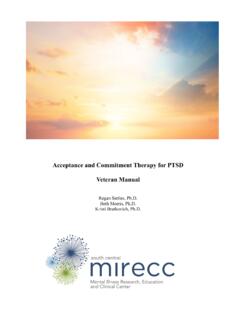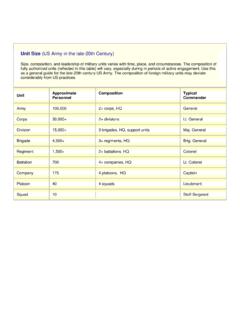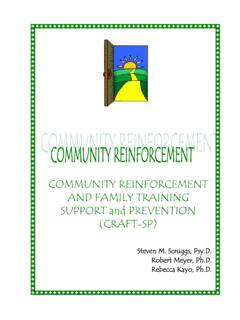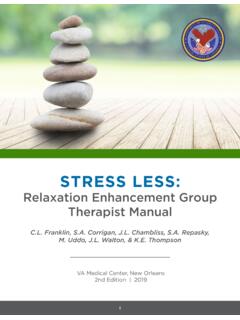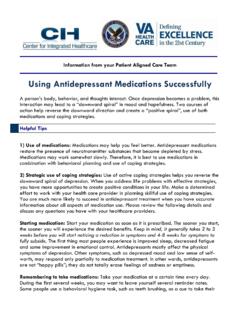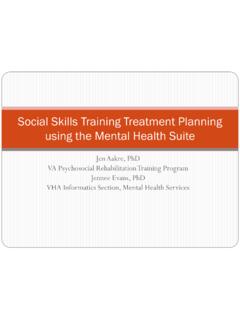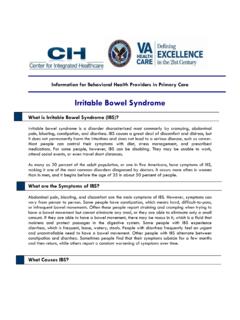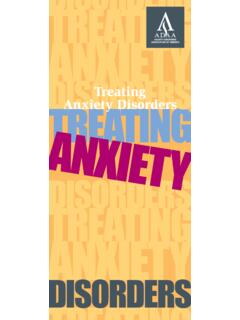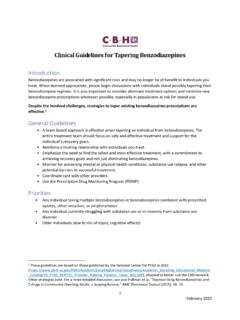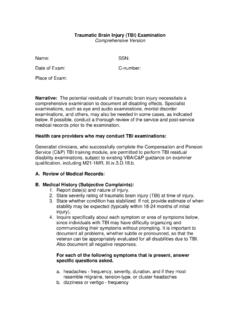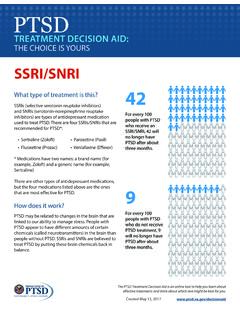Transcription of Acceptance and Commitment Therapy for PTSD Therapist …
1 Acceptance and Commitment Therapy for ptsd Group Manual Regan Settles, Beth Morris, Kristi Bratkovich, Table of Contents Manual Overview ..3 Session 0: Optional Pre-group Individual Session 1: Introduction to ACT ..11 Session 2: Willingness and 20 Session 3: Session 4: Personal Session 5: Willingness and Values-Based In Vivo 38 Session 6: Decision Points and Imagining Next 41 Session 7: Post-Exposure Session 8: Observing Session 9: Observing Self and Observing the Trauma 59 Session 10: Review and Wrap Up66 Appendix A: Responding to Challenges in Appendix B: Appendix C: Values Card Acknowledgements Portions of this manual were adapted from or influenced by the following sources: Follette, , & Pistorello, J.
2 (2007). Finding Life Beyond Trauma: Using Acceptance and Commitment Therapy to Heal Post-Traumatic Stress and Trauma-Related Problems. Oakland, CA: New Harbinger Publications. Harris, R. (2009). ACT Made Simple: An easy-to-read Primer on Acceptance and Commitment Therapy . Oakland, CA: New Harbinger Publications. Hayes, S. C., Strosahl, K. D., & Wilson, K. G. (1999). Acceptance and Commitment Therapy : an experiential approach to behavior change. New York: Guilford Press. Hayes, S. C., & Strosahl, K. D. (Eds.). (2005). A practical guide to Acceptance and Commitment Therapy . New York: Springer Science. Hayes, , & Smith, S. (2005) Get Out of Your Mind and Into your Life. Oakland, CA: New Harbinger. Juariscio, A., Shaw, J., Forman, E., Timko, , Herbert, J., Butryn, M., & Lowe, M. (2010) The WE-ACT Group: Weight and Eating Applications of Acceptance -Based Treatments. Unpublished Manual. Kabat-Zinn, J. (1994). Wherever you go, there you are: Mindfulness Meditation in Everyday Life.
3 New York: Hyperion. Stahl, B., & Goldstein, E. (2010). A Mindfulness-Based Stress Reduction Workbook. Oakland, CA: New Harbinger. Walser, & Westrup, D. (2007). Acceptance and Commitment Therapy for the Treatment of Post Traumatic Stress Disorder and Trauma-related Problems. Oakland, CA: New Harbinger Publications. Portions of session 10 were also adapted from sources on Dr. Russ Harris website: !" " ! This manual was developed with support from a South Central MIRECC clinical educator grant. The authors would like to thank the following individuals for serving as reviewers during the development of this manual: Expert Reviewers! Clinician Reviewers! Robyn Walser, ! Olivia Chang, ! Brian Thompson, ! Phillip Lehman, ! Susan Orsillo, ! Cheryl Bay, LCSW! Victoria Follette, ! Letta Jett, LCSW ! The authors would also like to thank Dr. Steven Scruggs, director of the Trauma and Deployment Recovery Services clinic at the Oklahoma City VA Medical Center, for providing administrative support for this project.
4 !" Manual Overview How to use this manual: The manual is designed for a group consisting of ten 90-minute sessions. The manual is set up to allow the group leader to balance fidelity to the core principles of ACT with flexibility to the individual needs of the group. For many sessions, there are core components and optional components. The group leader should ideally strive to cover all content and stay within the suggested time recommendations.
5 However, there may be times when a particular group is struggling to grasp a critical concept and clinical judgment suggests that strictly adhering to the outline would result in failure to understand a core concept. We encourage leaders to read the entire manual and practice skills themselves before beginning a group. This allows the leader to keep the big picture of ACT for ptsd in mind as they proceed through the group. This also helps group leaders better understand the experiential nature of learning in ACT. While content is important, the process of experiential learning is critical for veterans to develop greater psychological flexibility. ACT is best learned experientially. For this reason, new content is first experienced by group members. The ACT process is then named and its application is explained. Leaders should keep this process in mind when introducing new content: Experience it, Name it, Explain it. Components of ACT and their applicability to ptsd ACT targets experiential avoidance, which is the avoidance of emotional states, thoughts, and physiological experiences that are considered negative or unwanted.
6 Experiential avoidance is considered a normal human tendency that both patient and Therapist are likely to exhibit. From an ACT perspective, experiential avoidance is problematic for several reasons: (1) It does not actually get rid of the unwanted thought, emotion, or experience; (2) failed attempts to avoid painful internal experiences can result in an increased sense of failure and perceived brokenness, and (3) efforts to remove pain take tremendous amounts of energy that interfere with pursuing valued activities and relationships. As valued activities decrease, veterans daily life and sense of identity become increasingly defined by their trauma. Unlike cognitive behavioral therapies, the goal in ACT is not to reduce the presence of unwanted internal experiences. Instead the goal is to help veterans make room for their past traumas. This is referred to as psychological flexibility. The goal is for veterans to be able to acknowledge their negative internal experiences and pursue a meaningful life despite their presence.
7 This is accomplished through the following six core processes: Mindfulness: Veterans are first introduced to mindfulness as a way to reconnect with the present moment. This builds the foundation for increased exposure to avoided thoughts and emotions. Willingness: Willingness refers to being open to one s full experience, even if that experience is painful or anxiety provoking. This does not mean that the veteran likes or wants the pain and/or anxiety, rather that they accept its presence and create room for it. By taking a willing stance, veterans are able to move forward with important activities in the face of pain and anxiety. $" " Connection to Personal Values: Often veterans lives have become so dominated by avoidance that they have forgotten their own personal values.
8 A significant goal of ACT is help veterans reconnect with their personal values and to create discrepancy between trauma-driven behavior and behavior that is driven by values. Committed Action: Even when veterans are aware of their personal values, their behavior may still be driven by trauma. Committed action focuses on establishing clear goals to begin moving in the direction of one s values. In ACT for ptsd , veterans use their most important values to guide personal goals that become the basis for in vivo exposure activities throughout the group. In this manual, we refer to these as values-based exposure goals. Defusion: Through mindfulness practice, veterans become aware of painful thoughts that get in the way of them reaching their values-based goals. Defusion strategies help veterans learn to acknowledge their thoughts as just thoughts. Unlike more cognitive strategies, the goal is not to challenge thoughts but rather to acknowledge when they are not helpful, detach from them, and move forward.
9 It is not necessary to determine if they are true or untrue. Defusion strategies allow veterans to create distance from painful thoughts in order to continue committed action in the face of pain or anxiety. Observing Self: Finally, veterans learn to utilize their skills to take a big picture perspective of their life over time. This helps veterans moving forward to see painful experiences of the present moment in the broader context of life by connecting with the self that is constant across time. This connection with a constant sense of self promotes greater psychological flexibility and makes the experience of present anxiety less threatening. Exposure in ACT One of the primary goals of this protocol is to begin to facilitate in vivo exposure to avoided activities. The framework for exposures in ACT will differ from that of traditional exposure therapies. From an ACT perspective, the goal of exposure is not to experience anxiety reduction (although that can be a nice byproduct).
10 Instead, the goal is to increase psychological flexibility in the presence of painful and anxious internal experiences so that engagement in valued activities can be re-established. Readers are referred to Arch and Craske (2008) for a thorough discussion of the differences between ACT and cognitive behavioral Therapy elements, including the potential for values-based action to include exposure activities motivated by the individual s values rather than by symptom reduction. Starting in session 5, veterans will begin to select activities that will serve as in vivo exposures. Through early sessions, veterans should have identified discrepancies between their personal values and their behavior. These areas of discrepancy guide the selection of exposure exercises. Clinicians will need to carefully assess each veteran s goals to ensure that they have selected a goal that is both valued and that is avoided due to ptsd , not other causes ( ,, not exercising due to struggles with motivation).
